As she did last year, Gerri Haynes has organized a Washington Physicians for Social Responsibility delegation of doctors and other health care providers to work in hospitals and clinics in Gaza in an effort to directly help the people there and to bring attention to the ongoing humanitarian crisis that the Israeli blockade has created. She will be sending back reports from inside the Israeli blockade.
Today’s Blog was written by Bob Haynes who is seeing cardiac patients in Gaza
Cardiac Care rounds at Al Shifa Hospital, the largest (500 beds) Palestinian hospital in the West Bank and Gaza, are similar to those at any U.S. teaching hospital. Sleep-deprived interns present a patient’s history to an entourage of medical students and quizzing professors. The interns respond correctly with answers directly from the Mayo Handbook of Cardiology.
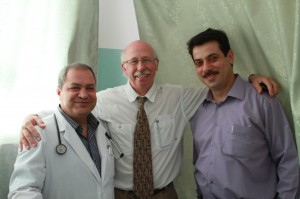
Bob Haynes with cardiology colleagues at Al Shifa. (Bob Haynes photo)
There is a concrete wall 10 meters high around the land border between Gaza and Israel and a sea embargo enforced by the Israeli navy. Goods not allowed into Gaza by Israel an Egypt include a list of essential medical items.
One decade ago in the U.S., care for an individual experiencing a heart attack changed from dissolving heart vessel clots with medicines to opening clogged arteries with tiny balloons on catheters. Balloon technology for heart attacks is not available in Gaza. These interns are very well versed in the use of the clot-dissolving technique. Their knowledge of this methodology is elegant and complete. These interns are sharp – their knowledge is 2010, but due to available technology, their practice is limited to 1990s.
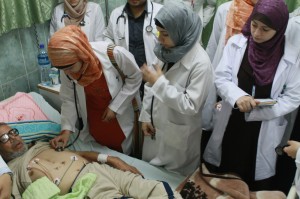
Medical students at Al Shifa Hospital examine a patient. (Bob Haynes photo)
Heroes and Families
Many physicians from Gaza leave to train abroad and are not allowed to re-enter Gaza for the six or more years of their training. Some remain abroad. Some heroes choose to return to Gaza to serve the population at home. Family membership provides a sense of meaning and purpose and belonging.
Families are identified with specific areas of Gaza. There are virtually no street names or addresses in this densely populated region. Seeking to find a specific home, the seeker questions local people about a “family” and is directed – or taken – to the correct home. Trust between a doctor and patient is established by identification of family.
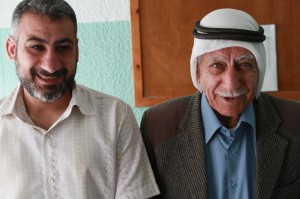
An uncle and his nephew. (Bob Haynes photo)
Despite layers of politics and the suffocating siege, the people of Gaza persevere and even thrive in their own ways on their land in their families.
As she did last year, Gerri has organized a Washington Physicians for Social Responsibility delegation of doctors and other health care providers to work in hospitals and clinics in Gaza in an effort to directly help the people there and to bring attention to the ongoing humanitarian crisis that the Israeli blockade has created. She will be sending back reports from inside the Israeli blockade.
Over and over again, we hear stories from women who are moving Gaza to strength and healing.
Today, several of our group met with the women of the Al Majd Women’s Center – a Palestinian NGO dedicated to “enhancing women’s role in society development and political participation through capacity building, awareness raising and formation of neighborhood committees.”
We heard the story of Nawal Al Gussen, the Center’s strong and capable director. Nawal is the mother of six and grandmother of eight. Four of her children were born prior to the ten-year imprisonment of her husband. Two children were born to them following his release from prison – these children are still in school.
Prior to imprisonment, her husband was a teacher at the UNWRA school. Since imprisonment, he is in conflict with the government and works at home – taking care of grandchildren, gardening and cooking. Nawal says they support each other – “he completes me and I complete him.”
One of their sons is now in an Israeli prison and her husband cares so much for the children of this son that the children refer to him as Baba (father).
Nawal wants women to be politically independent and strong and her work in the center reflects this desire.
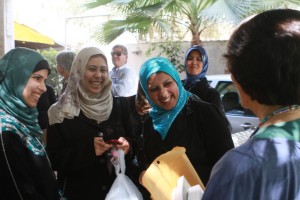
Palestinian students discussing the evolving role of women. (Bob Haynes photo)
The women discussed ways they have attempted to help their children cope – some now accompany their children even to the bathroom as the children fear being alone and feel exposed to the dangers of war.
David Hall talked with them about the strength they have in each other – in the group therapy that is present in their work with each other. The women expressed dismay that the world allows Israel’s blatant disregard for the Geneva Accords – and expressed their sadness that the Goldstone report has been disregarded by the international community. We promised to bring their stories back with us to the United States.
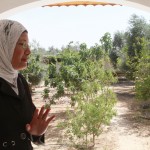
Suma Baroud (Bob Haynes photo)
Suma and her husband and five children served a delicious traditional Palestinian lunch, followed by tea in their beautiful garden.
One of the daughters was part of a delegation of Palestinian children to visit the White House in January. Their delegation met Jimmy Carter and Ban Ki Moon in New York. We were delighted to have the opportunity to meet Suma and her family.
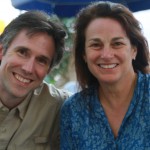
Laura Hart and Rich Grady at Marna House in Gaza. (Bob Haynes photo)
They have been warmly welcomed and are very busy doing surgical procedures in two Gaza City hospitals. They are spending mornings in Al Shifa Hospital and afternoons and into the late evening, operating in the Public Aid Hospital.
Rich is an international expert in the surgical treatment of bladder exstrophy and, by fortunate coincidence, will be here to care for a new infant with a need for surgical repair of the birth defect – bladder exstrophy. Laura reports that, as in every area of Gaza, new tools are needed but that Gaza’s surgeons are working valiantly and resourcefully with the equipment available and are eager to exchange ideas.
As she did last year, Gerri has organized a Washington Physicians for Social Responsibility delegation of doctors and other health care providers to work in hospitals and clinics in Gaza in an effort to directly help the people there and to bring attention to the ongoing humanitarian crisis that the Israeli blockade has created. She will be sending back reports from inside the Israeli blockade.
And so to the tunnels.
This is Friday, day of worship in the Muslim world. For our group, a day of rest and a time to take a wider look at the country we are visiting.
We traveled in a large bus with our hosts and friends from the northern border with Israel to the southern border with Egypt.
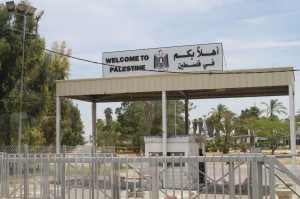
The crossing between Egypt and Gaza at Rafah. (Bob Haynes photo)
Along the way, we noted the areas where Israeli settlers once lived. In 2005, approximately 5,000 Israelis were evacuated from Gaza – moved by Israel to different homes in the Occupied Territories and Israel.
We learned that, while all of the settler homes were destroyed by Israel when Israel left Gaza to become an external occupier, several lovely schools and most of their greenhouses were left standing. Rubble from the destroyed houses has been cleared from the settler home sites – in part, at least, to use one day in the construction of a port.
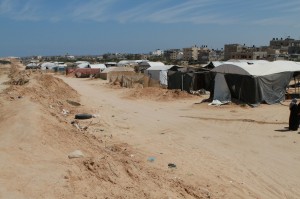
Land of the Tunnels: Each structure covers a tunnel. (Bob Haynes photo)
Basic necessities and many other items come through the tunnels: water, cloth, cars, motorcycles, building materials, camels, goats – almost any item that can claim a price. Several times in the last few days, we have seen shiny new cars in Gaza – successful navigators of the tunnels. Even brides have arrived in Gaza through the tunnels – carried sleeping through the underground passage.
While we visited the tunnels, we heard an explosion – we were told this came from the Egyptian side and was probably the destruction of a tunnel – its hiding place found. The tunnels are not legal.
As we traveled north to our hotel in Gaza City, we stopped to enjoy the Mediterranean Sea – with waters too polluted for swimming, the sites and sounds of the sea remain lovely. We shared lunch, games and conversation, then drove along the Sea to stop once more for ice cream and then to say farewell to our hosts.
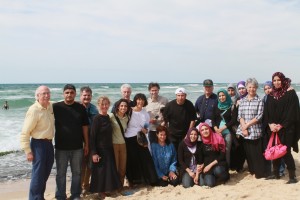
Seattle delegation and friends by the Mediterranean. (Bob Haynes photo)
Tomorrow is another day for work.
As she did last year, Gerri has organized a Washington Physicians for Social Responsibility delegation of doctors and other health care providers to work in hospitals and clinics in Gaza in an effort to directly help the people there and to bring attention to the ongoing humanitarian crisis that the Israeli blockade has created. She will be sending back reports from inside the Israeli blockade.
Members of our delegation continue to work in their areas of experience.
Howard Putter has been working with other orthopedic surgeons at Al Shifa Hospital. He has seen traffic trauma (the traffic in Gaza is the stuff of legend – there are no traffic lights for the heavy car and cart traffic and children play in and around the streets) and old war injuries. Attending orthopedists and a resident staff provide care – equipment and supplies are needed, but difficult to get during these years of siege.
David Hall taught an enthusiastically-received class on psychotherapy for psychologists, nurses and social workers this morning at the Gaza Community Mental Health Programme Center http://www.gcmhp.net/. Working through a series of translators, the discussion was spirited.
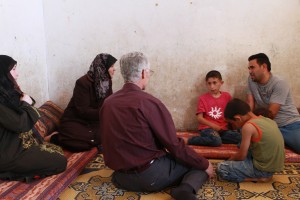
David Hall visits a patient at home. (Bob Haynes photo)
We are making some visits with GCMHP staff to private homes.
Today, we visited some members of a family of 16 who live on the fourth floor of a small concrete building – sleeping quarters are under an open tin roof, while the protected living happens in a space about 12×10.
The father of the family – which is composed of brothers and nieces and nephews as well as the wife and children of this father – is a fisherman. He tells us that the only fish in the waters they are permitted to fish (deep water fishing is prohibited by Israel) are very small and the water is sewage-polluted.
He has no income. The family receives food aid in the form of dry staples every three months from UNRWA http://www.unrwa.org/.
Their life is desperate. Still, the children gather and smile their beautiful smiles. Everywhere we go, people express gratitude that people from the United States have not forgotten them.
A federal judge Wednesday afternoon ordered filmmaker Joe Berlinger to hand over all of his footage from his documentary Crude to oil giant Chevron.
But early today Judge Lewis Kaplan stayed his decision and any due date for production of the footage until May 31st. But he did not stay his decision pending appeal. Before Judge Kaplan’s ruling, the Ecuadorian plaintiffs suing Chevron for deliberately dumping toxic waste into the Amazon rainforest filed an emergency stay motion with the Second Circuit Court of Appeals.
The motion says:
“For twent-five years, Chevron dumped billions of gallons of toxic waster into rivers, wells, drinking water and the land of thousands of indigenous residents and farmers in the Ecuadorian Amazon. Now, after seventeen years of litigation, including nine years fighting jurisdiction in the Southern District, and an over seven year litigation in Chevron’s chosen forum of Ecuador involving 200,000 pages of evidence, 63,000 chemical sampling results, testimony from dozens of witnesses, and dozens of judicial field inspections, Chevron seeks to subpoena 600 hours of footage from a prominent documentary filmmaker (Joe Berlinger) whose film, Crude, helped to expose and publicize Chevron’s conduct in the Amazon.”
In the motion to appeal, the plaintiffs argue that Chevron’s demand for the film footage will be a blow against journalists’ rights and will set a dangerous precedent.
As she did last year, Gerri has organized a Washington Physicians for Social Responsibility delegation of doctors and other health care providers to work in hospitals and clinics in Gaza in an effort to directly help the people there and to bring attention to the ongoing humanitarian crisis that the Israeli blockade has created. She will be sending back reports from inside the Israeli blockade.
The stories we are hearing as we go about our work are full of great sadness and often, great courage. This week marked the commemoration of The Nakba (Catastrophe) – the time 62 years ago when hundreds of thousands of Palestinians were driven from their homes as the state of Israel came into being.
Now, while the siege continues, these stories most frequently reflect the pain remaining from the thousands of deaths, tens of thousands of injuries and countless destruction resulting from the December 2008/January 2009 attacks by Israel on Gaza.
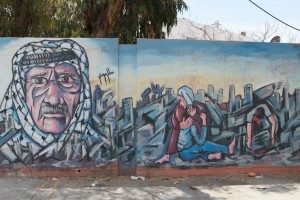
A wall painting commemorates the Nakba. (Bob Haynes photo)
Today, several members of our delegation were treated to a visit to a very special place: The Qattan Centre for the Child is directed by Reem, a brilliant woman of purpose.
During the summer, this center hosts 1,000 children per day – children using the library, doing art projects, learning about science, learning to use computers, participating in theatre productions.
The facility was funded by one individual – believing that education of children is the most essential need for a successful community.
This summer, UNRWA will again host the Summer Games for approximately 250,000 children of Gaza. Living only miles from the sea, some participating children will be seeing the Mediterranean for the first time. Swimming in the sea, however, is prohibited due to sewage pollution.
Bombing of Gaza’s infrastructure and prohibition of repair of these facilities due to siege restriction of supplies entering this land mandates that no one swim in the coastal waters of Gaza.
As we travel through Gaza City, we see an occasional new car. These cars enter the Gaza Strip through the tunnels from Egypt. We will visit these tunnels on Friday.
There have been so many stories recently from oil industry backers pointing out how the environmental disaster caused by the BP oil spill in the Gulf of Mexico is such a rare thing, that I thought I should run this press release from the Amazon Defense Coalition just as it came in by email this morning. I will update the story tomorrow after the hearing in Manhattan.
New York, New York (May 19, 2009) – Chevron’s attempt to use a U.S. federal court to gain access to more than 600 hours of private video outtakes of its Ecuador environmental disaster from the celebrated filmmaker Joe Berlinger has run into a groundswell of criticism as the issue heads up to an appellate court for judicial review.
A hearing to stay Chevron’s subpoena so the appeals court can consider the issue will take place today (May 19) at 2 p.m. before Judge Lewis Kaplan at 500 Pearl St. in Manhattan.
On Monday, the Ecuadorian plaintiffs suing Chevron for deliberately dumping billions of gallons of toxic waste into the Amazon rainforest appealed a decision by Judge Kaplan ordering Berlinger to turn over his entire body of his footage to Chevron. Berlinger shot the footage over a three-year period for a documentary on the lawsuit, Crude, that has garnered several awards and was one of the most critically acclaimed films of 2009.
Lawyers for Berlinger, who has vowed to fight Chevron, filed their notice of appeal last week. Berlinger is backed by the International Documentary Association, a group of filmmakers that includes 20 Academy Award winners, which issued a letter of support last week.
“Let us be clear about the important issue at stake: Chevron is trying to steamroll the First Amendment rights of a noted filmmaker as part of a campaign to evade accountability for an environmental disaster that has devastated the lives of thousands of people in the Ecuadorian Amazon,” said Ilann Maazel, a lawyer who represents indigenous groups suing the oil giant.
Judge Kaplan’s decision is being seen as an attack on the ability of filmmakers and journalists to cultivate sources and play their traditional watchdog role to ferret out corporate and governmental abuse. In interviews, filmmakers Michael Moore (FAHRENHEIT 9/11, BOWLING FOR COLUMBINE, ROGER & ME) and Ric Burns (ANDY WARHOL, NEW YORK) condemned the court’s ruling.
“It makes me shudder to think that all that stuff would be turned over…not because of any secrets that are revealed, but because of the killer blow to the trust a filmmaker cultivated, deeply, over a very long period of time,” Burns said in an interview.
Also among those speaking out against the oil giant:
• Journalist Bill Moyers, writing on The Huffington Post, said Chevron’s actions were putting in jeopardy “the whole integrity of the process of journalism…” He also said the case offers a clear argument for a federal shield law to protect journalists. His article can be viewed at: http://www.huffingtonpost.com/bill-moyers/chevrons-crude-attempt-to_b_576595.html.
• Trudie Styler, a film producer who co-founded the Rainforest Foundation with husband Sting, told Katie Couric of CBS News that Chevron’s move is “unheard of” and added that the oil giant had created a “hell” for the people of Ecuador. Her interview can be seen at http://www.cbsnews.com/video/watch/?id=6481132n.
• Moore, quoted in The New York Times, said of the Kaplan decision: “The chilling effect of this is … the next whistleblower at the next corporation is going to think twice about showing me some documents if that information has to be turned over to the corporation that they’re working for.”
• Burns labeled Judge Kaplan’s decision “insane” and said it could deliver a “killer blow” to how documentary filmmakers work.
Berlinger’s footage chronicles the Ecuador trial phase of the 17-year legal battle between indigenous tribes and the oil giant over massive oil contamination in Ecuador’s Amazon rainforest. The case, Aguinda v. ChevronTexaco, is considered the largest environmental action in the world, with damages estimated at up to $27.3 billion.
The case was moved from U.S. federal court to Ecuador at Chevron’s request in 2002. To induce the dismissal, Chevron at the time claimed that Ecuador’s courts were fair and that it would pay any adverse judgment. But now that the scientific evidence at trial proves Chevron is guilty, the company is trying to paint the trial as unfair and wrongly believes it can use the Berlinger footage for that purpose, said Maazel.
“Chevron’s real agenda is to intimidate journalists like Berlinger who have the courage to aim their lens at Chevron and expose the company’s human rights problems,” said Maazel. CRUDE was named one of the best documentaries of 2009 by the National Board of Review and won awards at 27 film festivals, in addition to being an official selection at Sundance.
Berlinger, who has won numerous awards for his documentaries, has credits that include METALLICA: SOME KIND OF MONSTER, PARADISE LOST, and BROTHER’S KEEPER. Berlinger is arguing that his footage is covered by First Amendment privileges that protect reporters and others in the newsgathering business from being compelled to reveal confidential sources and material.
The issue has become a flash point recently in the federal judiciary and has led some reporters to spend time in jail rather than disclose the identity of their sources.
The Aguinda plaintiffs separately argued in court filings that Chevron’s attempt to subpoena the footage amounted to little more than a “fishing expedition” designed to “silence filmmakers such as Joe Berlinger whose work (however evenhanded) has helped expose Chevron’s shocking and unconscionable misconduct.”
Chevron has admitted at trial that Texaco deliberately discharged billions of gallons of toxic wastewater into the streams and rivers of Ecuador while it was the exclusive operator of a large concession from 1964 to 1990. Evidence before the court indicates that cancer rates and other oil-related diseases in the area where Texaco operated have skyrocketed, decimating indigenous groups and poisoning the ecosystem in an area the size of Rhode Island.
As she did last year, Gerri has organized a Washington Physicians for Social Responsibility delegation of doctors and other health care providers to work in hospitals and clinics in Gaza in an effort to directly help the people there and to bring attention to the ongoing humanitarian crisis that the Israeli blockade has created. She will be sending back reports from inside the Israeli blockade.
The universal trauma to the people of Gaza continues to be central to the lessons we are learning.
The medicines we brought with us to the Gaza Community Mental Health Programme were received warmly – so many medicines are in short supply here.
The level of unemployment is very high (39% or much more) and we are learning of small businesses that are in development – attempts to provide family security in an insecure environment.
We are continuing with clinic and hospital work – and expanding our connections with the work going on in this imprisoned land.
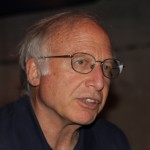
Dr. Don Mellman (Bob Haynes photo)
This afternoon, most members of our group visited the Islamic University and were treated to the end-of-the year senior science exhibits. Delightful creativity and hope were built into projects designed to improve automatic irrigation, mobile test-taking, emergency phone dialing, home security systems, jar sealing, home lighting control and dozens of others.
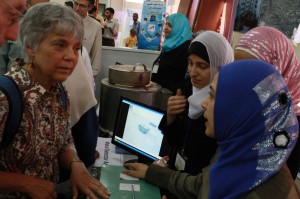
The WPSR delegation visits a student science exhibit. (Bob Haynes photo)
Again and again, resilience.
Our group: Physicians: Richard Grady, Pediatric Urology; David Hall, Child and Family Psychiatry; Laura Hart, Urology; Robert Haynes, Cardiology; Donald Mellman, Neurosurgery; Howard Putter, Orthopedics. Minister/counselor: Anne Hall. Nurse consultants: Debra Goff, Gerri Haynes.
For the next 9 days, Gerri Haynes will be sending back reports from inside blockaded Gaza. As she did last year, Gerri has organized a Washington Physicians for Social Responsibility delegation of doctors and other health care providers to work in hospitals and clinics in Gaza in an effort to directly help the people there and to bring attention to the ongoing humanitarian crisis that the Israeli blockade has created.
Working today in Gaza. In clinics and schools and in operating rooms, we are hearing from the people of Gaza about life under siege.
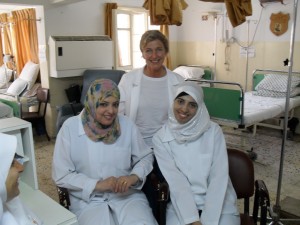
Photo by Sayed Elmasri
While the work for patients diagnosed with cancer is heroic, the treatment center lacks pain medicines, nutritional supplies, chemotherapeutic agents and radiation treatment facilities.
The presence of a cardiologist, a neurosurgeon, two urologists, a psychiatrist, and an orthopedic surgeon in our delegation was advertised in the local paper. People of Gaza are self-referring to be seen while we are here and the list of surgeries to be done in the next week is growing.
In the classes I taught at the Gaza Community Mental Health Programme today, we talked about the ongoing nature of traumatic stress – calling this “Continuous Traumatic Stress Injury”, rather than “Post Traumatic Stress Disorder.”
Resilience and care for each other from their community are essential parts of a society that is in a daily struggle to survive.
Personnel from the Gaza Community Mental Health Programme are providing ongoing assistance in refining our schedule for this visit – as new opportunities to meet and serve arise.
For the next 10 days, Gerri Haynes will be sending back reports from inside blockaded Gaza. As she did last year, Gerri has organized a team of doctors and other health care providers to work in hospitals and clinics in Gaza in an effort to directly help the people there and to bring attention to the ongoing humanitarian crisis that the Israeli blockade has created.
Again, in Gaza
This morning, our delegation was allowed to pass through Erez Checkpoint into Gaza. On the Israeli side, the director of Erez warmly welcomed us. The open tunnel that leads a walker to Gaza from the Israeli side was completed after our visit last fall. Concrete and barbed wire open to views of desolate land and armed Israeli guard towers.
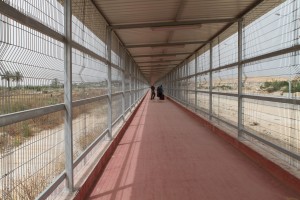
Members of the Washington Physicians for Social Responsibility delegation cross into Gaza. (Bob Haynes photo)
Nine delegates of Washington Physicians for Social Responsibility have come here to work with medical and allied health care colleagues. We are to attend to patients, consult and teach – while we learn about life here in 2010.
Our initial meeting with leaders of the Gaza Community Mental Health Programme, our host organization, was an introduction to the “situation” and to the work of the Mental Health Programme.
The majority of the 1.6 million residents of Gaza are traumatized – either directly by Operation Cast Lead, by the daily threat of further attacks or by the effects of the ongoing siege.
With this nearly universal level of trauma, Gaza Community Mental Health is striving to normalize individual responses to an abnormal situation. They are educating medical and allied health practitioners to care for the highest functioning individuals in primary care clinics. In this way, the most seriously affected individuals may be treated by the limited number of mental health specialists.
The siege, in place since 2007, denies residents of Gaza basic the needs of life: a variety of foods, building materials, electricity, fuel, medicines, school supplies…
We will be in Gaza for ten days, trying to understand. Already, we see the human spirit at work – many programs for children, empowerment clinics for women, reuse of materials retrieved from destroyed buildings, small business ventures in development – all attest to resilience and strength of community.
We are grateful to be here.